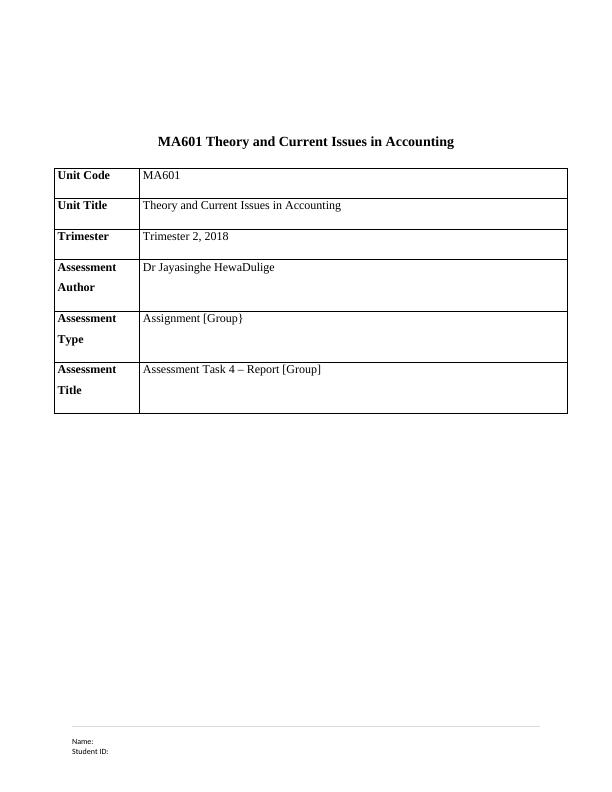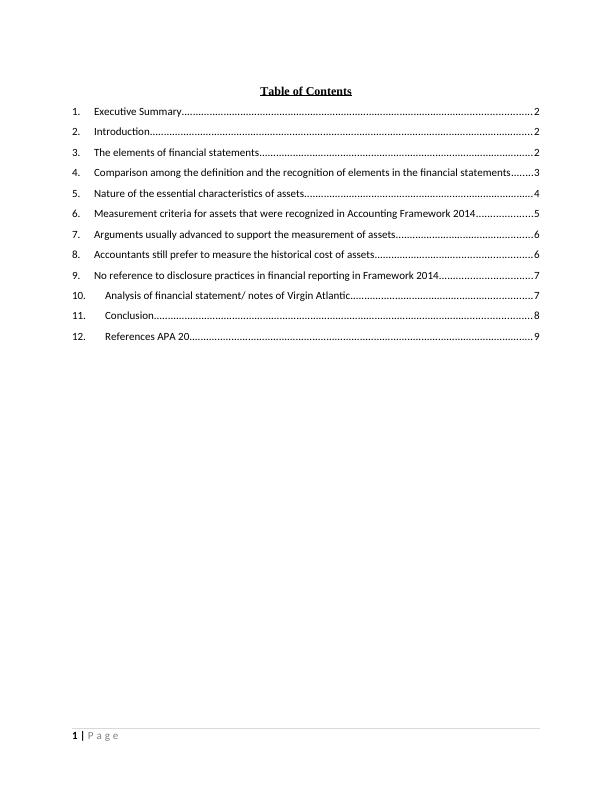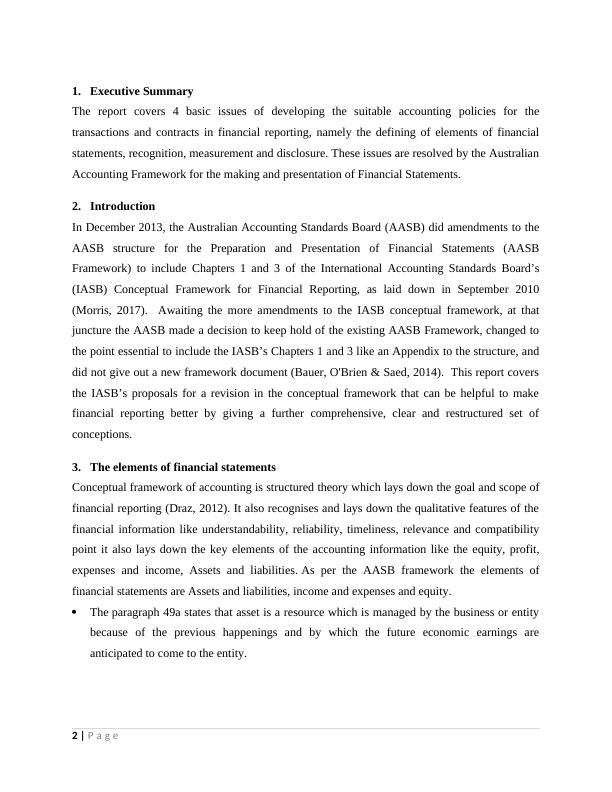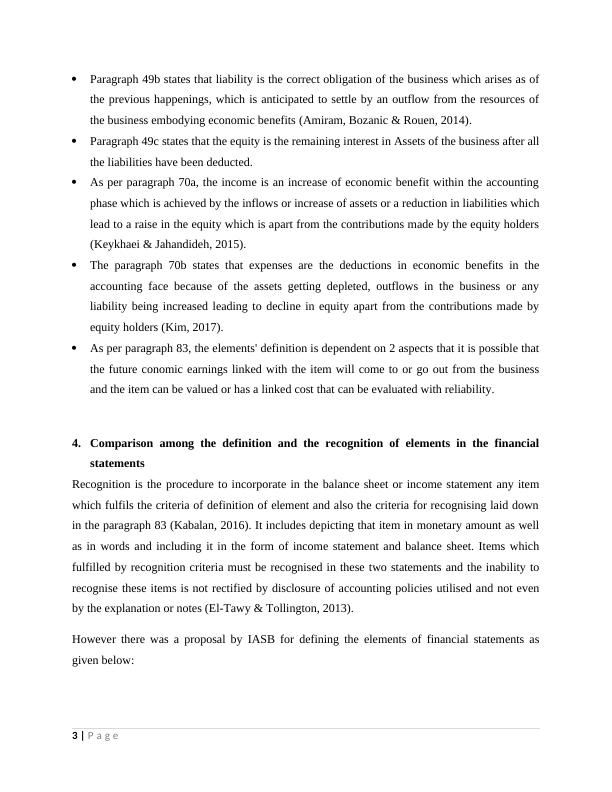Developing Suitable Accounting Policies for Financial Reporting
Added on 2023-06-05
11 Pages3575 Words345 Views
MA601 Theory and Current Issues in Accounting
Unit Code MA601
Unit Title Theory and Current Issues in Accounting
Trimester Trimester 2, 2018
Assessment
Author
Dr Jayasinghe HewaDulige
Assessment
Type
Assignment [Group}
Assessment
Title
Assessment Task 4 – Report [Group]
Name:
Student ID:
Unit Code MA601
Unit Title Theory and Current Issues in Accounting
Trimester Trimester 2, 2018
Assessment
Author
Dr Jayasinghe HewaDulige
Assessment
Type
Assignment [Group}
Assessment
Title
Assessment Task 4 – Report [Group]
Name:
Student ID:

Table of Contents
1. Executive Summary.............................................................................................................................2
2. Introduction.........................................................................................................................................2
3. The elements of financial statements..................................................................................................2
4. Comparison among the definition and the recognition of elements in the financial statements........3
5. Nature of the essential characteristics of assets..................................................................................4
6. Measurement criteria for assets that were recognized in Accounting Framework 2014....................5
7. Arguments usually advanced to support the measurement of assets.................................................6
8. Accountants still prefer to measure the historical cost of assets........................................................6
9. No reference to disclosure practices in financial reporting in Framework 2014.................................7
10. Analysis of financial statement/ notes of Virgin Atlantic.................................................................7
11. Conclusion.......................................................................................................................................8
12. References APA 20...........................................................................................................................9
1 | P a g e
1. Executive Summary.............................................................................................................................2
2. Introduction.........................................................................................................................................2
3. The elements of financial statements..................................................................................................2
4. Comparison among the definition and the recognition of elements in the financial statements........3
5. Nature of the essential characteristics of assets..................................................................................4
6. Measurement criteria for assets that were recognized in Accounting Framework 2014....................5
7. Arguments usually advanced to support the measurement of assets.................................................6
8. Accountants still prefer to measure the historical cost of assets........................................................6
9. No reference to disclosure practices in financial reporting in Framework 2014.................................7
10. Analysis of financial statement/ notes of Virgin Atlantic.................................................................7
11. Conclusion.......................................................................................................................................8
12. References APA 20...........................................................................................................................9
1 | P a g e

1. Executive Summary
The report covers 4 basic issues of developing the suitable accounting policies for the
transactions and contracts in financial reporting, namely the defining of elements of financial
statements, recognition, measurement and disclosure. These issues are resolved by the Australian
Accounting Framework for the making and presentation of Financial Statements.
2. Introduction
In December 2013, the Australian Accounting Standards Board (AASB) did amendments to the
AASB structure for the Preparation and Presentation of Financial Statements (AASB
Framework) to include Chapters 1 and 3 of the International Accounting Standards Board’s
(IASB) Conceptual Framework for Financial Reporting, as laid down in September 2010
(Morris, 2017). Awaiting the more amendments to the IASB conceptual framework, at that
juncture the AASB made a decision to keep hold of the existing AASB Framework, changed to
the point essential to include the IASB’s Chapters 1 and 3 like an Appendix to the structure, and
did not give out a new framework document (Bauer, O'Brien & Saed, 2014). This report covers
the IASB’s proposals for a revision in the conceptual framework that can be helpful to make
financial reporting better by giving a further comprehensive, clear and restructured set of
conceptions.
3. The elements of financial statements
Conceptual framework of accounting is structured theory which lays down the goal and scope of
financial reporting (Draz, 2012). It also recognises and lays down the qualitative features of the
financial information like understandability, reliability, timeliness, relevance and compatibility
point it also lays down the key elements of the accounting information like the equity, profit,
expenses and income, Assets and liabilities. As per the AASB framework the elements of
financial statements are Assets and liabilities, income and expenses and equity.
The paragraph 49a states that asset is a resource which is managed by the business or entity
because of the previous happenings and by which the future economic earnings are
anticipated to come to the entity.
2 | P a g e
The report covers 4 basic issues of developing the suitable accounting policies for the
transactions and contracts in financial reporting, namely the defining of elements of financial
statements, recognition, measurement and disclosure. These issues are resolved by the Australian
Accounting Framework for the making and presentation of Financial Statements.
2. Introduction
In December 2013, the Australian Accounting Standards Board (AASB) did amendments to the
AASB structure for the Preparation and Presentation of Financial Statements (AASB
Framework) to include Chapters 1 and 3 of the International Accounting Standards Board’s
(IASB) Conceptual Framework for Financial Reporting, as laid down in September 2010
(Morris, 2017). Awaiting the more amendments to the IASB conceptual framework, at that
juncture the AASB made a decision to keep hold of the existing AASB Framework, changed to
the point essential to include the IASB’s Chapters 1 and 3 like an Appendix to the structure, and
did not give out a new framework document (Bauer, O'Brien & Saed, 2014). This report covers
the IASB’s proposals for a revision in the conceptual framework that can be helpful to make
financial reporting better by giving a further comprehensive, clear and restructured set of
conceptions.
3. The elements of financial statements
Conceptual framework of accounting is structured theory which lays down the goal and scope of
financial reporting (Draz, 2012). It also recognises and lays down the qualitative features of the
financial information like understandability, reliability, timeliness, relevance and compatibility
point it also lays down the key elements of the accounting information like the equity, profit,
expenses and income, Assets and liabilities. As per the AASB framework the elements of
financial statements are Assets and liabilities, income and expenses and equity.
The paragraph 49a states that asset is a resource which is managed by the business or entity
because of the previous happenings and by which the future economic earnings are
anticipated to come to the entity.
2 | P a g e

Paragraph 49b states that liability is the correct obligation of the business which arises as of
the previous happenings, which is anticipated to settle by an outflow from the resources of
the business embodying economic benefits (Amiram, Bozanic & Rouen, 2014).
Paragraph 49c states that the equity is the remaining interest in Assets of the business after all
the liabilities have been deducted.
As per paragraph 70a, the income is an increase of economic benefit within the accounting
phase which is achieved by the inflows or increase of assets or a reduction in liabilities which
lead to a raise in the equity which is apart from the contributions made by the equity holders
(Keykhaei & Jahandideh, 2015).
The paragraph 70b states that expenses are the deductions in economic benefits in the
accounting face because of the assets getting depleted, outflows in the business or any
liability being increased leading to decline in equity apart from the contributions made by
equity holders (Kim, 2017).
As per paragraph 83, the elements' definition is dependent on 2 aspects that it is possible that
the future conomic earnings linked with the item will come to or go out from the business
and the item can be valued or has a linked cost that can be evaluated with reliability.
4. Comparison among the definition and the recognition of elements in the financial
statements
Recognition is the procedure to incorporate in the balance sheet or income statement any item
which fulfils the criteria of definition of element and also the criteria for recognising laid down
in the paragraph 83 (Kabalan, 2016). It includes depicting that item in monetary amount as well
as in words and including it in the form of income statement and balance sheet. Items which
fulfilled by recognition criteria must be recognised in these two statements and the inability to
recognise these items is not rectified by disclosure of accounting policies utilised and not even
by the explanation or notes (El-Tawy & Tollington, 2013).
However there was a proposal by IASB for defining the elements of financial statements as
given below:
3 | P a g e
the previous happenings, which is anticipated to settle by an outflow from the resources of
the business embodying economic benefits (Amiram, Bozanic & Rouen, 2014).
Paragraph 49c states that the equity is the remaining interest in Assets of the business after all
the liabilities have been deducted.
As per paragraph 70a, the income is an increase of economic benefit within the accounting
phase which is achieved by the inflows or increase of assets or a reduction in liabilities which
lead to a raise in the equity which is apart from the contributions made by the equity holders
(Keykhaei & Jahandideh, 2015).
The paragraph 70b states that expenses are the deductions in economic benefits in the
accounting face because of the assets getting depleted, outflows in the business or any
liability being increased leading to decline in equity apart from the contributions made by
equity holders (Kim, 2017).
As per paragraph 83, the elements' definition is dependent on 2 aspects that it is possible that
the future conomic earnings linked with the item will come to or go out from the business
and the item can be valued or has a linked cost that can be evaluated with reliability.
4. Comparison among the definition and the recognition of elements in the financial
statements
Recognition is the procedure to incorporate in the balance sheet or income statement any item
which fulfils the criteria of definition of element and also the criteria for recognising laid down
in the paragraph 83 (Kabalan, 2016). It includes depicting that item in monetary amount as well
as in words and including it in the form of income statement and balance sheet. Items which
fulfilled by recognition criteria must be recognised in these two statements and the inability to
recognise these items is not rectified by disclosure of accounting policies utilised and not even
by the explanation or notes (El-Tawy & Tollington, 2013).
However there was a proposal by IASB for defining the elements of financial statements as
given below:
3 | P a g e

End of preview
Want to access all the pages? Upload your documents or become a member.
Related Documents
Theory and Current Issues in Accounting - Assessment of Australian Accounting Standards Board’s Accounting Framework 2014lg...
|16
|3317
|395
Theory and Current Issues in Accounting - AASB Frameworklg...
|17
|3251
|127
Financial Accounting Australia News Letter Report 2022lg...
|10
|972
|14
Changes in the Conceptual Framework for Financial Reportinglg...
|16
|4117
|383
AASB 6: Inconsistencies with Conceptual Frameworklg...
|11
|2427
|162
The Conceptual Framework – Changes, Implications and Perceived Benefitslg...
|19
|4804
|63